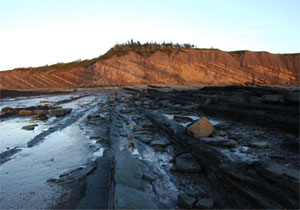 |
| Joggins Fossil Cliffs. |
John Calder still remembers the faces. A fresh-faced geologist with the Department of Natural Resources, he was asked by the deputy minister to go to the miners’ hall in River Hebert and tell the workers the last coal mine in the area was shutting down.
“These guys—coal mining is all they knew—and I had to tell them their livelihood was over,” says Dr. Calder, now senior geologist with the department and honorary adjunct professor with HÂţ»â€™s Department of Earth Sciences. “Every pair of eyes was glued to me and no was smiling. The weight on my shoulders was crushing. I promised myself, if there’s anything I can do to help out this community, I will.”
Yesterday, that weight lifted with the announcement that Joggins Fossil Cliffs was named a UNESCO World Heritage Site. The UNESCO designation came last night from Quebec City, where the World Heritage Committee conferred on several new additions to its list.
In Quebec City for the announcement, Dr. Calder says the anticipation throughout the day was unbearable—“it was just seemed like tick tock tick tock”—but worth it in the end. “There was this incredible sense of warmth that just wasn’t there for the other sites. The chair from Israel and other members of the panel at the podium were smiling down on us and people from countries all over the world were shaking our hands and saying congratulations. It was one of the nicest experiences I had in my life.”
|
“Phew! Elation and relief!” says Mr. Swinden, who got turned onto geology when his Grade 12 teacher in Truro took his class to Joggins on a field trip. “Most people felt very strongly that we had done everything that we could have done to give this nomination a chance of success … we made the case as well as it could be made, but you just never know, so we were all nervous.”
The Joggins Fossil Cliffs joins other sites of renowned including Slovakian wooden churches, two historic Malaysian trading towns and an early agricultural site from Papua New Guinea which were added to the UNESCO’s World Heritage List yesterday.
There are only 14 other world heritage sites in Canada and 855 sites worldwide. It's the second heritage site in Nova Scotia—the old town of Lunenburg was named to the list in 1995.
“I was walking around this morning, talking to myself, Joggins is a world heritage site – not it’s going to be, not I hope it will be, it is,” says Dr. Calder, who has been instrumental in the process over the past 16 years. “Wow. It’s amazing.”
Martin Gibling, professor of Earth Sciences at HÂţ», believes Joggins is a special place worthy of recognition because it exposes a complete ancient landscape, when Arthropleura sp, an invertebrate with a hard, jointed exoskeleton, scampered on mud with its 30 pairs of legs, and Hylonomus lyelli, the earliest known reptile, made its den inside a massive, hollow stump. Three-hundred million years ago, it was an area of coastal swamps with a hot, humid climate.Â
Joggins is unique because of the “standing trees,” coal-age trees which became fossilized where they originally grew, and logs, some an astounding 13-metres in length. The theory is that a series of rapid floods millions of years ago buried the trees upright in sand and mud. Locked in place over time, the trees decayed gradually without collapsing.
Joggins is also famous for its contribution to the history of geology. Sir Charles Lyell came to Joggins in the 1840s, and was highly impressed. He had written his famous Principles of Geology (1833), and it was this book that Charles Darwin carried with him on the voyage of the Beagle.
“Joggins was to Sir Charles Lyell what the Galapagos Islands were to Darwin,” says Dr. Gibling. “And it’s understandable: It’s one of the places in the world, perhaps better than anywhere else, where the whole ecosystem can be worked out in the rock record.”
